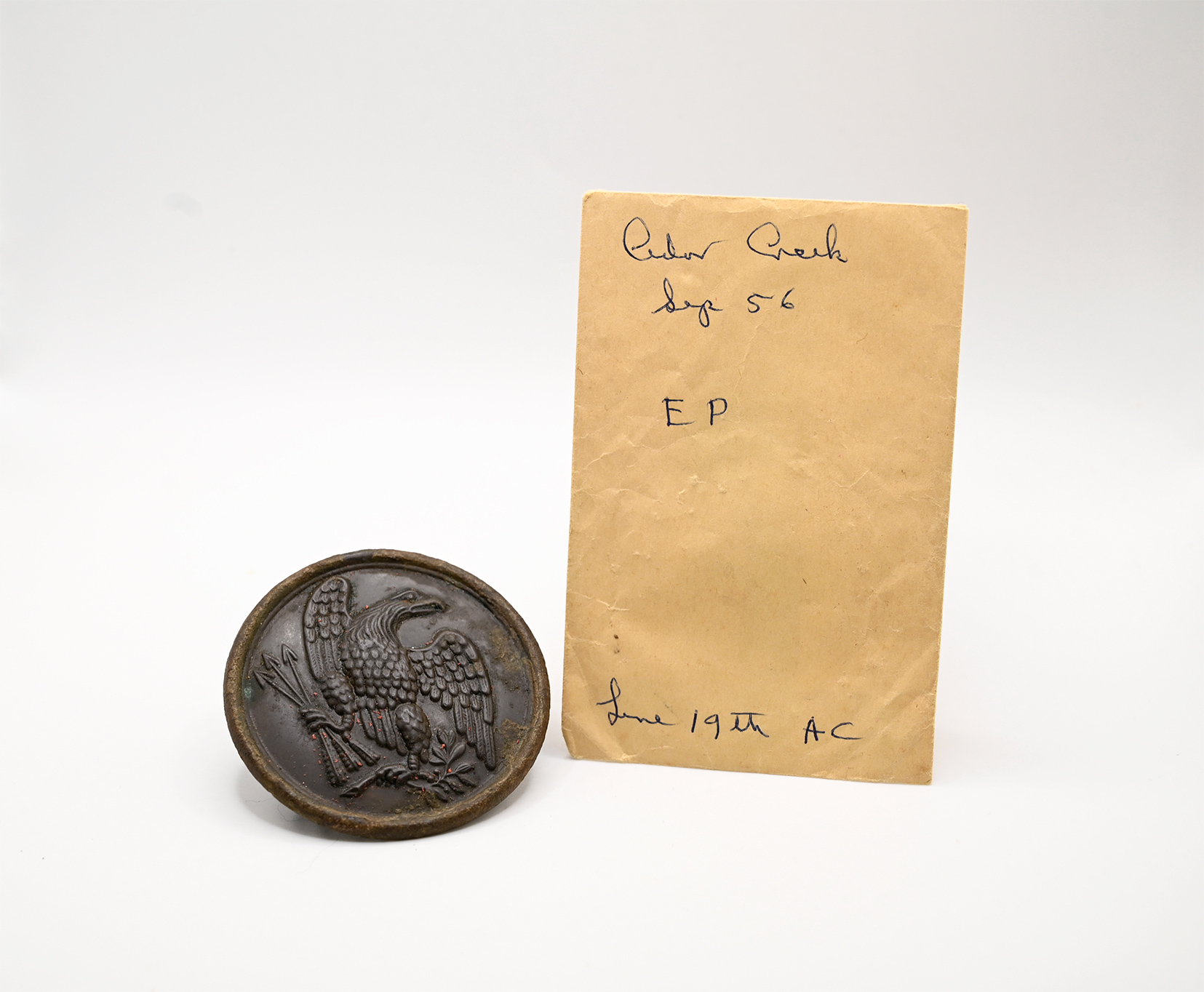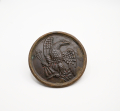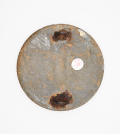site search
online catalog
CARTRIDGE BOX BELT PLATE FROM THE 19th CORPS LINE AT CEDAR CREEK, EX-KERKSIS

$450.00 SOLD
Quantity Available: None
Item Code: 2024-1731
This is an excellent excavated regulation US cartridge box plate recovered by Syd Kerksis, well known early relic hunter, collector and author of several respected books on Civil War material. It comes with Kerksis’s collection envelope bearing his notations that it was found at the Cedar Creek battlefield in September 1956 in a line held by the 19th Army Corps.
The plate has an excellent rim and crisp detail to the eagle, and shows as an even brown on the middle with just two corrosion spots at the 3:00 and 4:00 positions, and the surface of the rim showing as lighter brown with thin white. The reverse, with a subsequent collector’s small label on it, has a level surface to the lead solder fill showing gray with some cream color, a little light brown corrosion on the edges, both loops in place though showing rust, which stains the fill a little beneath them.
These plates were adopted in 1826 with hooks on the reverse for the bayonet shoulder belt and made of brass for artillery and white metal for infantry. This was changed to brass for both services in 1831 and when the bayonet was moved to the waist belt around 1842, the plates were redesigned with two loops on the back for wear as fixed ornaments on the cartridge box sling and plates with hooks were relegated to the NCO and musician’s sword shoulder belts. (Some militia versions used hooks at a different angle for wear on the waist belt.) Although in theory the plate was dropped with introduction of the 1864 cartridge box rigs with no plates, the plate remained in wide use in the field on the earlier pattern boxes and was not discontinued until the new 1872 sets of accouterments were distributed.
Cedar Creek will be familiar to most students of the war. On October 19, 1864, the Confederate Army of the Valley under Jubal Early launched a surprise attack against Sheridan’s Army of the Shenandoah, of which the 19th Corps and 6th Corps constituted the infantry, with the small Army of West Virginia under Crook attached. The initial Confederate attack was successful against Crook and Emory’s 19th Corps early in the day, netting numbers of prisoners and artillery pieces, while forcing back Union forces. Confederate momentum slowed, however, and Union forces ultimately rallied to win a decisive victory, usually credited to Sheridan’s timely and rapid return from a visit to Washington, though Horatio Wright, commander of the 6th Corps might have something to say about that.
This is a very nice looking plate with a great provenance, coming from a prominent early collector and a notable battlefield. [sr] [ph:m]
~~~~~~~~~~~~~~~~~~~~~~~~~~~~~~~~~~~
THIS ITEM, AS WITH ALL OTHER ITEMS AVAILABLE ON OUR WEB SITE,
MAY BE PURCHASED THROUGH OUR LAYAWAY PROGRAM.
CLICK HERE FOR OUR POLICIES AND TERMS.
THANK YOU!
Inquire About CARTRIDGE BOX BELT PLATE FROM THE 19th CORPS LINE AT CEDAR CREEK, EX-KERKSIS
For inquiries, please email us at [email protected]
Most Popular
Historical Firearms Stolen From The National Civil War Museum In Harrisburg, Pa »
Theft From Gravesite Of Gen. John Reynolds »
Selection Of Unframed Prints By Don Troiani »
Fine Condition Brass Infantry Bugle Insignia »
British Imported, Confederate Used Bayonet »
Piece Of Wood From The Room In The White House Where Lincoln Signed The Emancipation Proclamation »
featured item
THEFT FROM GRAVESITE OF GEN. JOHN REYNOLDS
A large artillery shell, one of pair that sit on either side of the grave of Gen. John F. Reynolds in Lancaster Cemetery, Lancaster, PA has been removed from the site. If anyone comes into contact with the shell or has any information regarding its… . Learn More »
site search
Upcoming Events
The shop will remain closed to the public through Friday, Jan. 31st, re-opening on Saturday, Feb.… Learn More »







